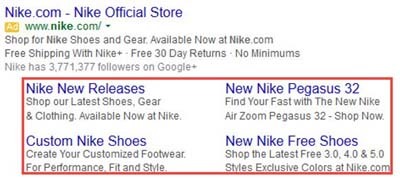This article explores the best practices for using Google sitelinks in ads. With the introduction of expanded text ads and various ad extensions, advertisers now have multiple options to enhance their ads. Sitelinks, in particular, are widely used in Google ads as they allow advertisers to include additional information below their ad and link to relevant pages on their website. The article outlines five key sitelink best practices that should be followed when implementing this type of extension in advertising accounts.
1 – Include Descriptions for Sitelinks
While it may seem obvious, many advertisers overlook the importance of adding descriptions to their sitelinks. Sitelinks provide additional options to users, but they should also be optimized for conversions. When linking to pages like “About Us” or testimonials, ensure that the pages have strong calls to action to encourage conversions.
2 – Create Sitelinks at the Campaign or Ad Group Level
Google offers the flexibility to add sitelinks at different levels: account, campaign, and ad group. To effectively target sitelinks, it’s recommended to create them at the campaign or ad group level. This allows for more granular targeting and serves the most relevant links based on the user’s search term. However, having account-level sitelink extensions as a catch-all can be beneficial if sitelinks are not specified at the campaign or ad group level. Account-level sitelinks should be more generic and align with your overall business.
3 – Utilize Sitelink Descriptions
Sitelinks offer two advantages: increased relevance and larger ad space. To maximize the impact of your ad, take advantage of sitelink descriptions. These descriptions provide additional information and make your ad more prominent. Having a larger, standout ad can significantly improve click-through rates (CTR).

By incorporating descriptions into your sitelinks, you can significantly increase the size of your ads. As shown in the image above, it’s like having three mini ads positioned right below your main ad.
4 – Implement Mobile-Optimized Sitelinks
Optimizing sitelinks for mobile devices requires a slightly different approach compared to computers. On computers, you typically display 2-6 sitelinks, while mobile and tablet devices can accommodate up to 8 sitelinks. Mobile sitelinks are presented in a carousel-style row, allowing users to scroll through them using their device’s touch screen.
Given the display format of mobile sitelinks, it is advisable to use shorter character counts. Google recommends aiming for 12-15 characters for mobile devices. Using shorter links allows you to display more sitelinks without requiring scrolling and reduces the risk of truncating longer sitelinks on smaller screens.
Another aspect to consider in mobile sitelink best practices is user intent. When crafting mobile sitelinks, keep the user’s needs and preferences in mind.
5 – Continuously Test New Sitelinks
Testing is crucial for any advertising campaign improvement, and sitelinks are no exception. While you cannot directly A/B test sitelinks against each other, you can analyze performance metrics for individual sitelinks.
Evaluate impressions, click-through rates (CTR), and conversion rates to assess the effectiveness of each sitelink. If you identify underperforming sitelinks, remove them and introduce new ones in their place.
Google’s algorithm favors sitelinks with better performance, so providing a variety of options is advantageous. Aim to have 8-12 sitelinks in each campaign or ad group at any given time.
We hope you have found these sitelink best practices helpful. If you have any additional sitelink tips or recommendations, we would love to hear from you in the comments section below.
